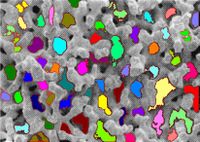This site is being phased out.
Flow-through pore diameters
Flow-through pore characteristics of monolithic silicas and their impact on column performance in high-performance liquid chromatography [1] by R. Skudasa, B.A. Grimesb, M. Thommesc and K.K. Ungera (Institut für Anorganische Chemie und Analytische Chemie, Johannes Gutenberg University, Duesbergweg 10-14, D-55099 Mainz, Germany) published in Journal of Chromatography A Volume 1216, Issue 13, 27 March 2009, Pages 2625-2636. Also in monograph Monolithic Silicas in Separation Science: Concepts, Syntheses, Characterization, Modeling and Applications edited by Klaus K. Unger, Nobuo Tanaka, Egidijus Machtejevas.
The idea is to examine the sizes of pores in the microscopy images (on the right), derive the permeability of the material from that data, and then compare to experimental results.
The image analysis was done manually (they call it "direct analysis") and then with Pixcavator: "The values estimated by the “Pixcavator” program were based on the area estimation via integrating the number of pixels in this area." (See Area.)
The comparison table is below.
The correlation looks good.


